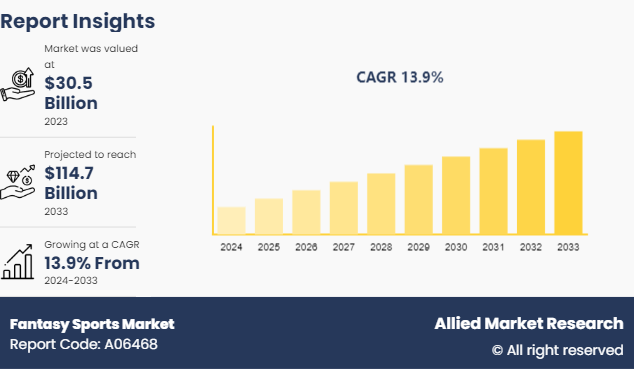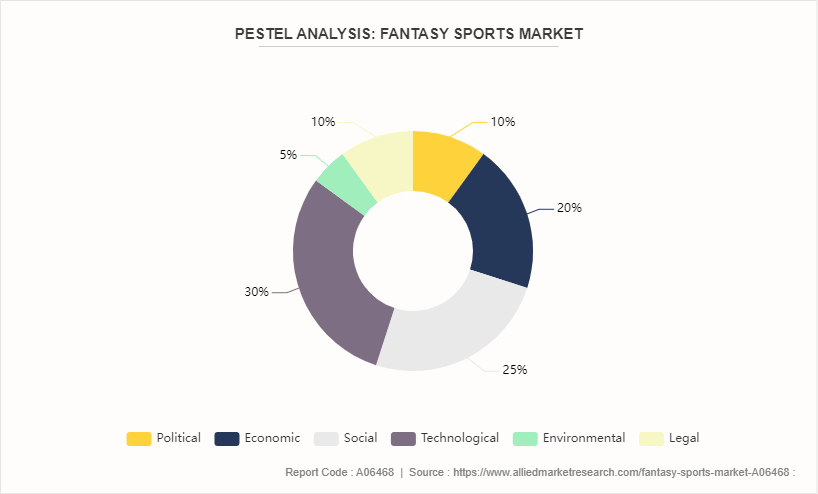Fantasy Sports Market Research, 2033
Market Introduction and Definition
The global fantasy sports market size was valued at $30.5 billion in 2023, and is projected to reach $114.7 billion by 2033, growing at a CAGR of 13.9% from 2024 to 2033. Fantasy sports are games played online in which players form virtual teams made up of real players from major sporting events. These virtual teams compete mainly on the picked athletes' statistical performance in live games. Participants receive points based on their selected players' real-life performance, intending to outperform other competitors' teams over the course of an entire season or series of matches. Fantasy sports' success derives from their immersive and participatory aspect, which increases fan engagement by creating a more substantive connection to the athletic event that is driving the fantasy sports market. The advent of mobile and internet-based applications has greatly improved availability and ease, allowing individuals to keep track of their squads in real-time. Furthermore, competitiveness and social features, in which users may compete against friends or the larger community, contribute to the attractiveness.

Key Takeaways
The fantasy sports market study covers 20 countries. The research includes a segment analysis of each country in terms of value ($Million) for the projected period 2024-2033.
More than 1, 500 product literatures, industry releases, annual reports, and other such documents of major fantasy sports industry participants along with authentic industry journals, trade associations' releases, and government websites have been reviewed for generating high-value industry insights.
The study integrated high-quality data, professional opinions and analysis, and critical independent perspectives. The research approach is intended to provide a balanced view of global markets and to assist stakeholders in making educated decisions in order to achieve their most ambitious growth objectives.
??????Key market dynamics
The increased availability of smartphones and broadband connections has made it simpler for people to access and interact with fantasy sports mediums, resulting in a bigger user base. While the growth of networking sites and online advertising has increased the reach and awareness of fantasy sports, they now draw a broad and worldwide audience. Furthermore, the ubiquity of sporting event broadcasting and the incorporation of real-time statistical analysis have improved the user experience, enabling more dynamic and participatory gameplay. The increased legalization and regulation of wagering on sports in many jurisdictions has given the fantasy sports market a considerable boost, legitimizing and extending business potential.
Regulatory issues remain a key impediment since varied regulatory frameworks across countries tend to restrict access to markets and create uncertainties for operators. In some nations, strong gambling regulations classify fantasy sports as gambling and impose limits or full prohibitions. Concerns about data security and privacy are also growing, given the large volumes of financial and personal data collected by these platforms. Significant data breaches can undermine user trust and discourage new participation. The competitive environment is also a double-edged sword; although it encourages innovation, it is susceptible to market saturation and expensive client acquisition costs, especially in established markets.
Expanding into emerging economies, where rising internet penetration and an increasing number of middle classes with disposable financial resources are generating a new and enthusiastic user base. A further significant?potential is the emergence of smartphones and app-based platforms, which allow consumers to interact with fantasy sports smoothly and on the move, widening the market to a younger, more tech-savvy clientele. The combination of modern technologies such as machine learning, AI, and blockchain has significant innovation potential, allowing for more personalized user experiences, improved data security, and clear incentive systems.
PESTEL Analysis of Global Fantasy Sports Market
Political
The legality of fantasy sports varies greatly. For instance, in the U.S., ?the Unlawful Internet Gambling Enforcement Act of 2006 exempts fantasy sports from the definition of gambling since they are considered games of skill. However, in nations such as India, the legal structure is more opaque, with various rules applied across states.
Economic
Disposable income has a direct influence on user involvement. The average expenditure per user in North America, a key market, is much higher than in other areas, suggesting larger disposable incomes and a greater proclivity to spend on recreational activities.
Social
The fantasy sports market mostly attracts younger viewers. According to a 2021 poll conducted by the Fantasy Sports & Gaming Association (FSGA) , 50% of fantasy sports participants in the United States are between the ages of 18 and 34.
Technological
The development of smartphones and mobile applications has revolutionized the fantasy sports experience, thus making it available from anywhere and at any time. For instance, FanDuel and DraftKings, offer mobile applications that increase user engagement and have simple user interfaces.
Environmental
While fantasy sports have a lower environmental effect than physical sports, organizations are more focused on digital sustainability. For instance, decreasing server energy use and pushing digital advertising over traditional print advertising.
Legal
Compliance with data protection standards, such as the GDPR in Europe and the CCPA in California, is critical. Fantasy sports services gather massive volumes of user data, needing strict data security protocols.

Market Segmentation
The fantasy sports industry is segmented into sports type, platform, demographics and region. On the basis of sports type, the global market is classified into football, baseball, basketball, hockey, cricket, and others. On the basis of platform, it is bifurcated into website, and mobile application. On the basis of demographics, the market is divided into Under 25 Years, 25 to 40 Years, and Above 40 Years and Region wise, the fantasy sports market is analyzed across North America, Europe, and Rest of World.
Regional/Country Market Outlook
North America, specifically the U.S., continues to be the largest and most developed market. The growing recognition of major sports tournaments such as the NFL, NBA, and MLB drove the number of fantasy sports participants in the U.S.?to around 60 million by 2022. The market is likely to expand further, aided by the rising legalization of sports betting in additional states, which improves the credibility and accessibility of fantasy sports.
Due to the immense appeal of football (soccer) and cricket, the market in Europe is fast increasing, particularly in the United Kingdom, Germany, and Spain. The United Kingdom, with its widely recognized gambling legislation, provides an ideal setting for the expansion of fantasy sports, aided by a high internet access rate and a strong sports culture.
Asia-Pacific is rising as a profitable industry, with India leading the way, owing to cricket's tremendous popularity and the widespread use of mobile internet. Companies like Dream11 dominate this market, demonstrating the region's enormous potential. However, regulatory ambiguity remains an issue, since different states in India take different positions on the legal status of fantasy sports.
Brazil and Argentina?are seeing potential growth in Latin America as a result of football's appeal and a burgeoning middle class with increased internet access.
In conclusion, while North America is the dominating market, major fantasy sports market demand prospects exist in Europe, Asia-Pacific, and Latin America, subject to regulatory reforms and technical breakthroughs that enable more access and interaction.
??????Industry Trends:
According to the Fantasy Sports & Gaming Association (FSGA) , there are projected to be 50.4 million fantasy sports enthusiasts in the U.S.?by 2022, up from 42 million in 2015. In 2022, the overall amount of fantasy sports players in North America was 62.5 million, with the United States accounting for slightly more than 80% of the total.
The National Football League (NFL) and DraftKings Inc., a famous digital sports gaming and entertainment company known for its daily fantasy sports and sports betting mobile applications, recently announced a collaboration to broaden current daily fantasy sports (DFS) and content collaborations into Canada. The development of an expanded arrangement strengthens the two organizations' relationship, and it will also enhance the DFS customer experience across the country as the NFL season approaches the Super Bowl.
Yahoo, an American multinational technology company, purchased?Wagr, a social sports betting start-up located in Nashville, in April 2023. By incorporating Wagr into its company, Yahoo hopes to expedite its aim of developing and providing the most fascinating fantasy and gaming products while fostering associate collaboration.
Competitive Landscape
The major players operating in the market contributing to the fantasy sports market size include Dream Sports, DraftKings Inc., fantacalcio, Fanduel (Flutter Entertainment) , Rotoworld, FantasyPros, Rotowire, Fantrax, Sportech Inc., and NFL Fantasy.
Other players in market competing to increase their fantasy sports market share includes CBS Sports Digital, Realtime Fantasy Sports Inc., Pure Win (Sweetspot N.V.) , FantasyPros.com, MY11Circle, NBC Sports Edge (NBC Sports Group) , MyFantasyLeague (Sideline Software Inc.) , Office Football Pool (OFP Hosting Inc.) , MPL, and Ballebaazi, and others
Recent Key Strategies and Developments
In March 2023, DraftKings Inc. announced intentions to establish its famed online sportsbook in Massachusetts, pending licensing and regulatory permission. Boston-based DraftKings will open its online sportsbook in Massachusetts, making it the 21st state in the nation. DraftKings will provide Massachusetts consumers with access to a variety of bet options, including same-game combinations, player accessories, unique odds, boost selections, and more, as well as appealing and exclusive incentives.
In January 2023, Fantasy Akhada announced plans to sell a large interest to GMR Sports, a GMR Group affiliate, for around USD 160-175 million (INR 1, 300-1, 400 crores) . The purchase is expected to take place in phases, with GMR finishing up in subsequent rounds and replacing some early investors.
In May 2022, The Swedish website Fotbollskanalen obtained FSport's flagship fantasy sports offering from the gaming and media firm headquartered in Helsingborg. FSportwill collaborate with TV4 to supply the Football Channel with its FSportFree product and accompanying daily fantasy sports platform. According to their agreement, TV4 will promote the games on its website and social media channels under a new fantasy sports brand and enable people to engage in free-to-play games.
Key Benefits For Stakeholders
- This report provides a quantitative analysis of the market segments, current trends, estimations, and dynamics of the fantasy sports market analysis from 2024 to 2033 to identify the prevailing fantasy sports market opportunities.
- The market research is offered along with information related to key drivers, restraints, and opportunities.
- Porter's five forces analysis highlights the potency of buyers and suppliers to enable stakeholders make profit-oriented business decisions and strengthen their supplier-buyer network.
- In-depth analysis of the fantasy sports market segmentation assists to determine the prevailing market opportunities.
- Major countries in each region are mapped according to their revenue contribution to the global market.
- Market player positioning facilitates benchmarking and provides a clear understanding of the present position of the market players.
- The report includes the analysis of the regional as well as global fantasy sports market trends, key players, market segments, application areas, and market growth strategies.
Fantasy Sports Market Report Highlights
| Aspects | Details |
| Market Size By 2033 | USD 114.7 Billion |
| Growth Rate | CAGR of 13.9% |
| Forecast period | 2024 - 2033 |
| Report Pages | 200 |
| By Sports Type |
|
| By Platform |
|
| By Demographics |
|
| By Region |
|
| Key Market Players | Rotowire, Fantrax, Dream Sports, Fanduel (Flutter Entertainment), Sportech Inc., NFL Fantasy, FantasyPros, DraftKings Inc., Rotoworld, Fantacalcio |
The global fantasy sports market was valued at $30.5 billion in 2023, and is projected to reach $114.7 billion by 2033, growing at a CAGR of 13.9% from 2024 to 2033
The fantasy sports market registered a CAGR of 13.9% from 2024 to 2033.
The forecast period in the fantasy sports market report is from 2024 to 2033.
The top companies that hold the market share in the fantasy sports market include Dream Sports, DraftKings Inc., fantacalcio, Fanduel (Flutter Entertainment), Rotoworld, and others.
The fantasy sports market report has 3 segments. The segments are sports type, platform, and demographics.
Loading Table Of Content...



